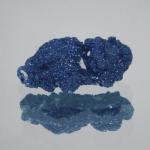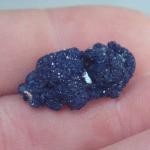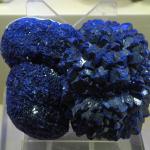
Classes- Alabama
- Alaska
- Arizona
- Arkansas
- California
- Colorado
- Connecticut
- Delaware
- Florida
- Georgia
- Hawaii
- Idaho
- Illinois
- Indiana
- Iowa
- Kansas
- Kentucky
- Louisiana
- Maine
- Maryland
- Massachusetts
- Michigan
- Minnesota
- Mississippi
- Missouri
- Montana
- Nebraska
- Nevada
- New Hampshire
- New Jersey
- New Mexico
- New York
- North Carolina
- North Dakota
- Ohio
- Oklahoma
- Oregon
- Pennsylvania
- Rhode Island
- Tennessee
- Texas
- Utah
- Vermont
- Virginia
- Washington
- West Virginia
- Wisconsin
- Wyoming
| Structure : Monoclinic Hardness : 3.5 Specific Gravity : 3.77 Refractive index : 1.73 - 1.8 Doubly Refracting (bi-refraction) : 0.11 Azurite, also known as Chessylite, is a soft and deep blue copper mineral produced by the weathering of copper ore deposits. Early accounts of the mineral were reported in Pliny the Elder's Natural History, as kuanos, Greek for deep blue, the Latin name Caeruleum, and the English word cyan. The name Azurite itself references the blue color of the mineral. Due to the blue color, the stone has been associated with low humidity deserts and winter skies for centuries. The name Azurite also references a Persian word, lazhward, an area rich in lapis lazuli, another deep blue stone. Reasons for Proper Care If exposed to the elements for a prolonged period of time, the mineral will lighten in color, and the surface will become malachite, the soft, swirly patterned green stone. As a copper element, Azurite will be destroyed, turning black, if heated. Possible Confusion Azurite and ultramarine can be determined from one another by heating. As stated above, Azurite will turn black, whereas ultramarine will withstand the heat. Jewelry Uses Azurite may sometimes be seen as beads and in jewelry, but due to the minerals softness and tendency to break down into malachite, the use is fairly limited. The use of malachite, however, is often seen as beads. Collector's Stone Azurite is more of a collector's stone. The deep blue is much appreciated, but the fact remains that the stone loses its color by simply being exposed to bright light, heat or open air. Unless a person can keep the stone away from these common elements, it becomes difficult to retain a pristine specimen of Azurite. In essence, a collector should keep Azurite in a cool, dark and sealed environment, for its best chances at preservation. Early Confusion Azurite and malachite are excellent copper ore indicators. This fact led indirectly to the name of the element nickel in the English language. Niccolite, a principal ore of nickel, weathers at the surface into a green mineral (annabergite) that resembles malachite. Niccolite requires higher temperatures than copper ore to be properly smelted, and the many attempts to smelt the niccolite, failed. This mineral came to be known in Germany as kupfernickel, literally translating into "copper demon". The Swedish alchemist Baron Axel Fredrik Cronstedt realized that there was probably a new metal hiding within the niccolite ore, and in 1751 he succeeded in smelting niccolite to produce a previously unknown (except in certain meteorites) silvery white, iron-like metal. Logically, Cronstedt named his new metal after the nickel part of kupfernickel. An unintended consequence of his choice is that later, both Canadian and American coins worth one-twentieth of a dollar, are now named after the German word for "demons"—that is, they are called nickels. Toxicity All copper minerals are toxic and should not be ingested. Ordinary handling of azurite poses no significant threat. With Azurite being a soluble copper mineral, Azurite poses a threat to aquatic life and should not be used as a decorative stone in a fresh-water aquarium and most definitely not in a salt-water aquarium. |
- Birth Stone Gems
- Wedding & Anniversary Gems
- How To Guides
- Fireable Gems
- Nonprofits and Guilds
- Gem Show
- Gem Stone Information
- ·Abalone
- ·Achroite (Tourmaline)
- ·Agate ( Chalcedony)
- ·Alexandrite
- ·Almandine ( Garnet )
- ·Amber
- ·Amethyst ( Quartz)
- ·Ammolite
- ·Andalusite
- ·Andradite Garnet
- ·Apatite
- ·Aquamarine ( Beryl )
- ·Aventurine ( Quartz )
- ·Azurite
- ·Benitoite
- ·Bloodstone ( Chalcedony )
- ·Brown Quartz ( Smokey Quartz )
- ·Calcite
- ·Carnelian ( Chalcedony )
- ·Cassiterite
- ·Celestine
- ·Cerussite
- ·Chalcedony
- ·Chatoyant Quartz
- ·Chrysoberyl
- ·Chrysocolla
- ·Chrysoprase (Chalcedony)
- ·Citrine ( Quartz )
- ·Coral
- ·Danburite
- ·Diamond
- ·Diopside
- ·Dioptase
- ·Dravite ( Tourmaline)
- ·Emerald ( Beryl )
- ·Enstatite
- ·Epidote
- ·Euclase
- ·Fire Agate (Chalcedony)
- ·Fluorite
- ·Gold
- ·Goshenite (Beryl)
- ·Grossular Garnet (Tsavorite Garnet)
- ·Gypsum
- ·Heliodor ( Beryl )
- ·Hematite
- ·Hessonite (Grossular Garnet)
- ·Imperial Topaz
- ·Indicolite ( Tourmaline)
- ·Iolite
- ·Ivory
- ·Jadeite
- ·Jasper (Chalcedony)
- ·Jet
- ·Kornerupine
- ·Kunzite
- ·Kyanite
- ·Labradorite
- ·Lapis Lazuli ( Lazurite)
- ·Lazulite
- ·Malachite
- ·Meerschaum
- ·Microcline
- ·Milky Quartz
- ·Moonstone
- ·Morganite ( Beryl)
- ·Nephrite ( Jade)
- ·Obsidian
- ·Oligoclase
- ·Onyx
- ·Opal
- ·Orthoclase
- ·Padparasha ( Corundum)
- ·Pearl
- ·Peridot
- ·Pink Topaz ( Mercury Myst Vapor )
- ·Plasma ( Chalcedony)
- ·Prase ( Chalcedony )
- ·Prehnite
- ·Pyrite
- ·Pyrope ( Garnet )
- ·Rock Crystal ( Quartz )
- ·Rubellite ( Tourmaline)
- ·Ruby ( Corundum)
- ·Sapphire ( Corundum)
- ·Sardonyx ( Chalcedony)
- ·Scapolite
- ·Schorl (Tourmaline)
- ·Shell
- ·Spessarite (Garnet)
- ·Sphalerite
- ·Spinel
- ·Spodumene (Hiddenite - Triphane)
- ·Tanzanite (Zoisite)
- ·Tektites ( Moldavite )
- ·Tiger Eye
- ·Titanite (Sphene)
- ·Topaz
- ·Turquoise
- ·YAG (Garnet)
- ·Zircon


